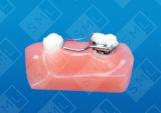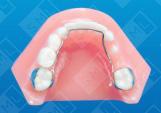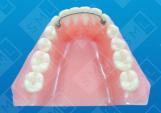Developed to overcome the complaints that patients expressed when wearing a Herbst appliance (particularly regarding the bulk in the lower bicuspid area), the MARA (Mandibular Anterior Repositioning Appliance) is attached to stainless steel crowns on the first molars. Crowns are preferred over bands because they are needed to help withstand the tremendous leverage forces generated by the appliance. In addition to the normal rectangular arch wire tube, the upper first molar has a large .062 square tube, which accepts an adjustable .060 square “elbow” that hangs vertically.
The lower first molar has the normal rectangular tube -- as well as an .059 round wire “arm” projecting buccally from the mesial. The upper elbow hits the lower arm and prevents the teeth from occlusion, unless the patient holds the lower jaw forward so that the lower arm is in front of the elbow. Typically, the lower crowns or bands are stabilized by either a lingual arch or lower braces to prevent unwanted mesiolingual rotation of the lower molars (resulting from the resting pressure of the elbows). Additional mandibular advancement is achieved by periodically placing shims on the elbows. The elbows are held in place with either elastics or ligature wire.
Most skeletal Class II cases -- with normally positioned maxillas and retrognathic mandibles -- have constricted maxillary arches. In these situations, a Hyrax Screw is typically used to help develop the narrow maxillary arch and is usually soldered to the lingual of the crowns. It incorporates occlusal rests on the first bicuspids, which may be bonded with composite for additional retention. If the maxillary arch is normal in width, a transpalatal arch is typically used -- to aid in anchoring the molars and help properly distribute the forces generated by the appliance.











